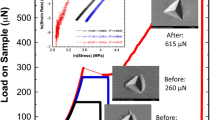Abstract
The impurity crack tip shielding/antishielding stress intensity factor is found for equilibrium impurity concentrations near the crack tip for a crack tip with or without a plastic zone. It is found that the impurity atoms produce either no shielding/antishielding stress intensity factor or only a very small shielding/antishielding stress intensity factor. However, if the impurity concentration near a crack tip is perturbed from equilibrium values the possibility arises that appreciable crack tip shielding/antishielding can exist. If a small elastic enclave exists between the crack tip and the plastic zone, impurity atoms also may be able to produce an appreciable crack tip shielding/antishielding.
Résumé
On établit le facteur d'intensité de contrainte caractérisant la couverture ou non par un nuage d'impuretés de l'extrémité d'une fissure, dans le cas de concentrations d'impuretés en équilibre au voisinage de cette extrémité, qu'il y ait ou n'y ait pas zone plastique. On trouve que les atomes d'impuretés ne conduisent qu'à un facteur d'intensité d'entaille de valeur faible, voire nulle. Toutefois, s'il y a perturbations par rapport aux valeurs d'équilibre de la concentration en impuretés près de l'extrémité de la fissure, il devient possible qu'existe une couverture/anticouverture appréciable de cette extrémité. Ceci peut également être provoqué par les atomes d'impuretés lorsque il existe une petite enclave élastique entre l'extrémité de la fissure et la zone plastique.
Similar content being viewed by others
References
J. Weertman and J.E. Hack, International Journal of Fracture 30 (1986) 295–299.
S.S. Hecker, M.G. Stout and D.T. Eash, in Plasticity of Metals at Finite Strain: Theory, Computation and Experiment, E.H. Lee and R.L. Mallett (eds.) Division of Applied Mechanics, Stanford University and Department of Mechanical Engineering and Mechanics, Rensselaer Polytechnique Institute (1982) 162.
G. Langford and M. Cohen, Transactions ASM 62 (1969) 623.
J. Weertman and S.S. Hecker, Mechanics of Materials 2 (1983) 89.
J.C. Amazigo and J.W. Hutchinson, Journal of the Mechanics and Physics of Solids 25 (1977) 81.
J. Weertman, Internatonal Journal of Fracture 30 (1986) 67–75.
Author information
Authors and Affiliations
Additional information
This research has been performed under the auspices of the U.S. Department of Energy.
Rights and permissions
About this article
Cite this article
Weertman, J., Hack, J.E. Crack tip shielding/antishielding by impurity atoms. Int J Fract 36, 27–34 (1988). https://doi.org/10.1007/BF00034815
Received:
Accepted:
Issue Date:
DOI: https://doi.org/10.1007/BF00034815




